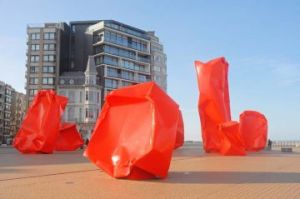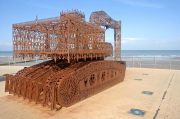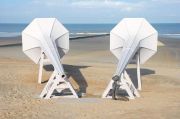 |

|
 Ostend, Rocks Strangers © T.Joly Ostend, Rocks Strangers © T.Joly

|
Whether in France or Belgium, the Flanders coast has pleasant surprises in store for contemporary art lovers. They have the choice betweens museums with rich collections and monumental works installed in nature.
[ Practical ]
Getting there
- By road
300 km from Paris to Dunkirk on autoroutes A1 and A16.
315 km from Paris to Ostend on autoroutes A1 and A22 till Belgium, then on autoroutes A17, A10 and A18 till Ostend.
- Train
TGV from Paris Gare du Nord to Dunkirk. The journey takes from 1 h 40 to 2 h 20.
Thalys TGV from Paris Gare du Nord to Brussels, then train from Brussels to Ostend. The journey lasts approximatively 3 hours.
Lodging
Hotel Burlington, in Ostend
Hotel Honfleur, in Middelkerke
Hotel ter Zilte, in Nieuwpoort
Welcome Hotel, in Dunkirk
Hotel Bed and Boat, in Dunkirk
Restaurants
‘T Landhuys, in Ostend
Dolce Mare, in Ostend
Vierbote, in Nieuwpoort
Hostellerie Le Fox, in De Panne
Le Sweet, in Dunkirk
L’Epicurien, in Dunkirk
Beaufort 2015 edition
beaufort2015.be
Information
- Flanders Coast Tourist Office
www.lelittoral.be
- Nord-Pas-de-Calais Tourist Office
www.tourisme-nordpasdecalais.fr
In Ostend and vicinity, walking along the shores of the North Sea is like wandering through a large open-air museum. Ironworks excavator, man riding a giant turtle, phonograph horns seeming to broadcast music to fishes and many other contemporary sculptures and installations indeed stand along the beaches. These works are not there by chance. They were created within the framework of a contemporary art festival called Beaufort, referring to the Beaufort scale, which measures the wind intensity.

 Westende, Caterpillar 5bis © T.Joly Westende, Caterpillar 5bis © T.Joly
|
 In situ works In situ works
Initiated in 2003 and likely to extend in France in the future, this three-yearly event indeed asks to thirty artists to produce in situ works in ten Belgian coastal towns, from Knokke-Heist on the East to De Panne near the French border. The twenty or so permanently visible works are those that were acquired by municipalities over the editions.
Right in the city centre of Ostend, the Rocks Strangers by artist Arne Quinze are installed on the waterfront. On the beach of Westende, are the Caterpillar 5bis by Wim Delvoye and Latvia Ivars Drulle’s work entitled "I can hear it " installed near the Grand Hotel Bellevue, also called" La Rotonde ", an Art Deco building where the Belgian royal family once spent vacations. In Nieuwpoort, near the King Albert I monument commemorating the 1914 battle of the Yser, hundred flagpoles topped by multicoloured windsocks compose Daniel Buren’s work entitled " The Wind blows wherever it pleases ".

 Westende, I can hear it © T.Joly Westende, I can hear it © T.Joly
|
 James Ensor’s house James Ensor’s house
As for the Christophorus by Gerhard Lentink, a wooden sculpture depicting a man whose trunk is replaced with a seat, it stands in the dunes of De Panne. To discover all these works there is no need of a car because they are all accessible by a cycle trail and the world’s longest tramway line, both running along the entire Belgian coast.
The area also boasts many other sites worth a visit for modern and contemporary art lovers. Housed in a building representative of post-war architecture, the former department store of a cooperative, the Muzee of Ostend regularly hosts contemporary art exhibitions and contains a large collection of works by Belgian artists from 1850 to the present day such as painters Leon Spilliaert and James Ensor. Also situated in Ostende, the former house of the latter is open to the public. It only contains reproductions of his works, but several rooms retain their original appearance and plunge visitors into his world.
 Weird shaped building Weird shaped building
In particular, the souvenir shop that his uncle and aunt ran on the ground floor and the Blue Room where the artist lived and worked.
On the other side of the border, just 20 kilometres from Belgium, the port of Dunkirk is one of the most dynamic French cities regarding modern and contemporary art thanks to the presence of two museums, the LAAC and the FRAC Nord-Pas-de-Calais. Created in 1982 at the initiative of Dunkirk collector Gilbert Delaine, the first is housed in a weird shaped building covered with white ceramic tiles surrounded by a pond and a garden peppered with sculptures. It contains nearly 2,000 works representing all major art movements from the 40s to the 80s. Cobra formed by Karel Appel, Constant, Corneille, Christian Dotremont, Asger Jorn and Joseph Noiret illustrated with one of the largest collections of works of this kind.
 XXth century art movements XXth century art movements
Abstract Expressionism or New York School represented by works by Paul Jenkins and others artists. New Realism with works by Caesar and Arman. Lyrical Abstraction, a movement claiming the legacy of Kandinsky to which Joan Mitchell belonged. Narrative Figuration, New Figurative and Hyperrealism illustrated by works by Herve Telemaque, Bernard Roncillac, Klasen and Jacques Monory. Supports/Surfaces, a French group represented by Claude Viallat and Christian Jaccart. Works by artists from Northern France like Jean Roulland, Edouard Pignon and Arthur Van Hecke.
As for the FRAC Nord-Pas-de-Calais, it is the oldest in France. Created in 1983, it hosts temporary exhibitions and presents a selection of the 1500 works acquired over the years. Since 2013 it occupies a glass and steel structure taking the shape of the building to which it is attached, a former construction hall of the shipyards that were once the city’s pride.
 Chapel of Light Chapel of Light
If you want to know more about the rich maritime history of Dunkirk, head to the Port Museum in front of which are moored two ancient ships open to the public. The three-masted square-rigged tall ship Duchesse Anne, a former German training ship given to France as war damage, and Sandettie a former lightship.
To finish this contemporary art tour, let’s go to Bourbourg near Gravelines, to see the Saint Jean-Baptiste church. Partially destroyed during WWII, it has undergone restoration since the 60s and, in 2000, British artist Antony Caro has been asked to decorate its gothic choir. Inaugurated in 2008 and titled “The Chapel of Light”, his work comprises liturgical furniture and fifteen sculptures made out of wood, steel, iron and concrete that trace the origin of Man and Earth in a raw and pared-down style.
April 30, 2015
Thierry Joly 

|



